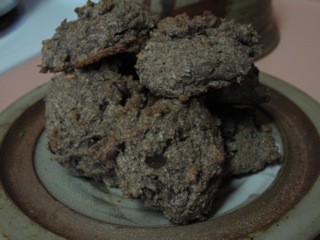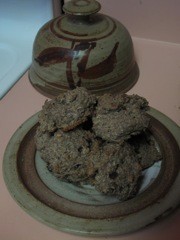How’s that for alliteration 😉
Well, having a gluten-free partner sure does change your life (thanks Phillip!) 😉 To tell you the truth, I was critical of the gluten-free revolution. I thought that a lot of funny non-native products were being packaged and sold to the lost gastronomic cultural crowd of Americans like so many other products. I have my criticisms — of course (like, do you NEED to label dried fruit as ‘gluten-free’…the marketing is out of control on this). However, experimenting with the new flours has been an illuminating journey for me.
I’m sure you’ve noticed more and more people around you realizing they are gluten-intolerant or…a far more serious situation…they may have Celiac Disease. Basically, these people cannot eat and digest gluten. Where do we find gluten? It is found in the wheat tribe of grains — that is, wheat, rye, barley, spelt, kamut — these are the main culprits. And, guess what — this overly processed form of wheat in the modern diet makes everything that much worse. People who are gluten-intolerant may feel full after eating only a few bites of something; they are easily fatigued; they are nutrient-deficient because of an inability to absorb and utilize nutrients; and they typically feel nauseous after eating something with gluten.
Needless to say, many Central and Northern Europeans used grain. However, they fermented or soaked the whole wheat or rye grains before making their breads. Sourdough is a great example of how the wheat grain went from something relatively unfit for digestion to something highly fit for digestion (more available nutrients and increased nutrient amount!). Also, these ancestors of many US folk had a nut-based diet as well. It was very common, in the times when the forests of Europe were healthier, to use hazelnut, chestnut, and a bit further South, almond, as flours for breads (these were soaked or sprouted as well). So, this return to nut flours, root flours and legume flours might be a return to our traditional food ways.
***Side note: We soak, sprout, or ferment our grains, legumes and seeds to deactivate an enzyme-inhibitor that is locked into the skin/coating of that seed (well, this is one main reason why). This is a natural mechanism in germination, so that the seed keeps until it is ready to sprout. When the enzyme-inhibitor is released, a host of nutrients become available for we humans. And, it doesn’t tax our existing enzyme stores in the digestion of this seed when we do eat it. Fermenting our grains is a traditional method known throughout the world.***
Back to gluten-intolerance…maybe other things are going on in the human system besides gluten-intolerance. There could be a fungal overgrowth in the system due to the more acidic pH in the body caused by the consumption of refined flours and sugars. Any way you spin it, if you feel like you have the symptoms above — STOP eating gluten. Begin fermenting (sourdough, etc) and experiment with the medley of interesting flours out there these days! Begin building back your gut health and strengthening your digestive fire with proper eating, exercise (not strenuous!), and sleep…and nurse yourself back to wellness.
My top flour picks are: buckwheat flour, cassava flour, nut meals (almond meal, etc), and sorghum flour… Check out Moon Rabbit for gluten-free mixes.
When you eat glutenous flours, I suggest soaked or sprouted grains. The folks at Grindstone Bakery do it right.
Ok, enough of that — time for the cookie recipe!
Coconut Coriander Carob Cookies (gluten-free)
*Use coconut oil and a nut-based milk instead of butter/milk to make this recipe vegan-friendly
**Toss in a handful of your favorite dried fruit to add a new level of yumminess (I just added cranberries…which would add one more ‘c’ to the cookie’s name)
Preheat oven to 325 degrees
In a medium-sized bowl mix:
1 tablespoon Tapioca Flour
2 tablespoons Fine Coconut Flakes
3 tablespoons Almond Meal
3 tablespoons Buckwheat Flour
1/4 teaspoon Baking Powder
1/8 teaspoon Baking Soda
1/4 teaspoon Sea Salt
1/2 teaspoon Coriander Powder
1/4 cup (heaping) Carob Chips (you can use Dark Choc if you want)
In the blender mix (just 5-10 seconds to mix ingredients):
2 tablespoons Maple Syrup
3 tablespoons Coconut Oil (or butter, cut into small pieces first)
1/2 cup Almond, Oat, Coconut, Dairy Milk (just under a 1/4 cup!)
1/2 teaspoon Vanilla
2 tablespoons Crunchy Peanut Butter
Grease cookie sheet with Coconut Oil or Butter. Add wet mix to dry mix and stir. Should not be too moist (a spoonful would roughly hold its form). Drop spoonfuls of dough onto cookie-sheet. This should give you a dozen small cookies. Put in the over for about 15-20 minutes. Keep them in a little longer if they haven’t browned on the edges well enough. Take out and let cool for a few minutes — Enjoy!


I am so excited that you mention baking with fermented grains. I was just wondering about this. Can gluten intolerant folks eat wheat and other grains if they have been fermented?
If you are gluten-intolerant, I would suggest ordering sprouted flour from these folks (http://www.organicsproutedflour.net/) and treating it with a sourdough process (double digest that gluten!). Order spelt or kamut as they are more ancestral varieties…wheat has really been over-hybridized. I think that along with unnatural processing of the wheat has led to such high levels of gluten-intolerance. With any grain…it is good to ferment (sourdough) or soak (with an acid) before using it to bake with…